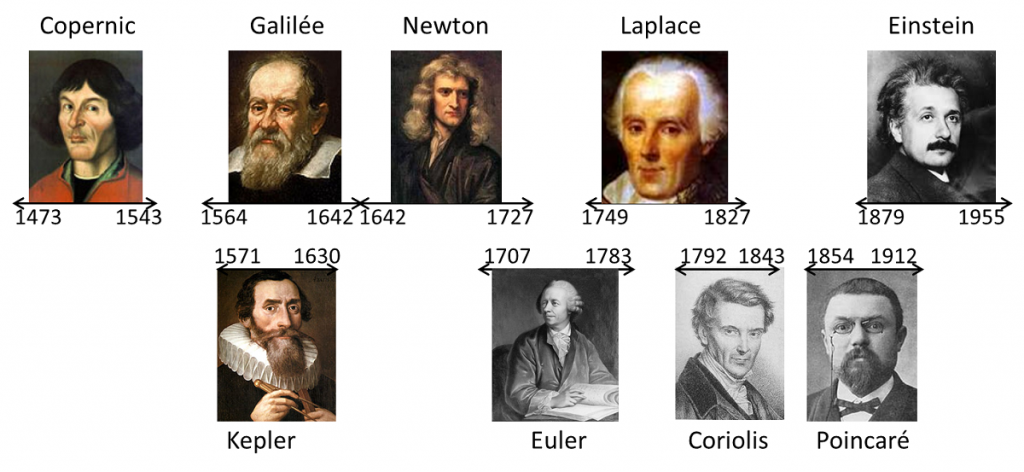A brief history of the dynamics
PDFThe laws of mechanics are rooted in the progress of astronomy, starting with the work of Nicolas Copernicus, who proclaimed that the Earth revolves around the Sun in the same way as the other planets. A careful measurement of the movement of the planets then led to the laws of elliptical trajectories formulated empirically by Johannes Kepler. These laws proved to be more precise than the combinations of circular trajectories (epicycles) inherited from ancient Greece. The discovery of Jupiter’s satellites by Galileo, thanks to the astronomical telescope, made it possible to find these same laws of planetary motion in this miniature solar system, reinforcing the idea of a universal gravitational force.
These advances in astronomy have led to the application of the same physical laws to celestial bodies as to terrestrial objects, contrary to ancient conceptions that attributed to them a perfect and unchanging nature. Galileo also laid the foundations for dynamics by setting out the fundamental principles of inertia and equivalence between heavy and inert mass. Isaac Newton is responsible for the precise formulation of the laws of motion, describing how speed and position vary over a short period of time. This is called a differential equation. The explicit calculation of trajectories by explicit resolution of such equations is only possible in special cases. Many mathematicians have been working on this task since Newton, in particular Pierre-Simon de Laplace and Léonard Euler, who also extended these laws to fluids. Gaspard Coriolis, for his part, introduced the force that now bears his name to express the laws of mechanics in a rotating reference frame (although Laplace had already obtained the same results in a different form).
The use of the laws of dynamics has expanded considerably in the 20th century with the advent of computer calculation, making it possible to tackle complex problems such as weather forecasting. The equations of motion are then solved numerically in successive steps from an initial condition. A similar approach, known as the dynamic system approach, underlies forecasting models in fields as diverse as demography, economics or road traffic. However, these iterative methods are not without limitations because numerical errors accumulate with each time step. Many complex systems are called chaotic, in the sense that such errors grow exponentially, so that prediction becomes almost impossible after a certain period of time called predictability. Weather forecasts would thus basically be limited to a deadline of around fifteen days. In the longer term, however, statistical modelling is possible, allowing climate prediction. However, this presupposes respecting the properties of the model, and in particular its conservation laws such as that of energy. Dynamic systems are thus the subject of numerous mathematical studies aimed at better understanding their behaviour and statistical description over long periods of time, following an approach initiated by the mathematician Henri Poincaré.
A limitation of Newton’s laws appeared at the end of the 19th century following the observation that light, and more generally the electromagnetic waves that had just been discovered, always propagate at the same speed. These waves were then considered to be vibrations of a fluid medium called ether, and their observed propagation rate should have varied according to the speed at which the Earth moved relative to this medium. This contradiction was resolved by Albert Einstein by assuming that a moving observer perceives a different time and distance from the “fixed” observer, so that the light wave appears to always propagate at the same speed. According to his theory of relativity, the speed of light is a limit never reached by a massive particle: the inertia of the particle increases as it approaches this limit, preventing a further increase in speed. The famous relationship E = mc2 is linked to this increase in inertia (mass m) with energy E. Zero mass particles such as photons, or gravitational interactions, propagate at the speed of light. All these Einstein predictions have been accurately confirmed by experience.
A second difficulty appeared at the same time to describe the movements at the scale of the atom, which led to the advent of quantum mechanics. This made it possible to accurately describe the structure of atoms, their radiation spectrum and ,chemical properties. It is also what makes it possible to design the components used in electronics and computer science.
Relativity and quantum mechanics however, are related to Newton’s mechanics. The fundamental laws of conservation of energy, quantity of motion and kinetic moment thus remain valid, but in modified forms. In addition, Newton’s laws are found for objects of macroscopic dimensions within the limit of low speeds compared to that of light, thus reinforcing their application to the dynamics of the environment.





